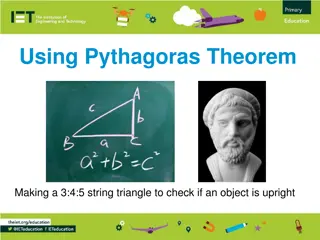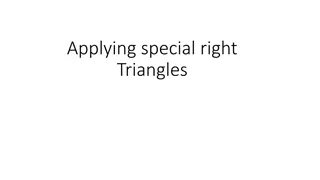Understanding the Pythagorean Theorem and Right-Angled Triangles
Explore the Pythagorean Theorem, which states that in a right-angled triangle, the square of the length of the hypotenuse (c) is equal to the sum of the squares of the other two sides (a and b). Learn how to identify the hypotenuse, use the theorem to find missing lengths, and visually understand the theorem through squares and dissections. Witness the silent teacher's demonstration to grasp the concept effectively.
Download Presentation

Please find below an Image/Link to download the presentation.
The content on the website is provided AS IS for your information and personal use only. It may not be sold, licensed, or shared on other websites without obtaining consent from the author. Download presentation by click this link. If you encounter any issues during the download, it is possible that the publisher has removed the file from their server.
E N D
Presentation Transcript
From last lesson: Pythagoras Theorem c2 = a2 + b2 We can use this formula to find missing lengths in right-angled triangles, where a and b are the sides either side of the right angle, and c is the hypotenuse. c a b
From last lesson: Pythagoras Theorem c2 = a2 + b2 a2 can be thought of as the area of a square with length a c a2 a b
From last lesson: Pythagoras Theorem c2 = a2 + b2 b2 can be thought of as the area of a square with length b c a b b2
From last lesson: Pythagoras Theorem c2 = a2 + b2 c2 can be thought of as the area of a square with length c c2 c a b
From last lesson: Pythagoras Theorem c2 = a2 + b2 So according to Pythagoras Theorem, the sum of the areas of the two smaller squares is equal to the square on the hypotenuse.
From last lesson: Pythagoras Theorem c2 = a2 + b2 Watch Perigal s dissection here Watch another representation of the theorem here
Before we begin, lets make sure we know how to identify which side is the hypotenuse. For the next three slides, identify which side is the hypotenuse.
How can we use it to find the length of the hypotenuse in a right-angled triangle? c2 = a2 + b2
The silent teacher The whole class will watch me very carefully in silence as I silently demonstrate the example. It is important that nobody asks questions during this time. I will pause at key moments in the process. At these points you should try to think what is going to happen next. Once I have done this (about 2 minutes) I will talk through the example and take questions.
Now lets talk through it. Example: ?? = ?? + ?? Any questions? 25cm2 9cm2 3cm ? 4cm 16cm2 So ? = 25 So ? = 5
Your turn (on your whiteboards) Example: ?? = ?? + ?? 25cm2 ? 9cm2 3cm ? 6cm 8cm 4cm 16cm2 So ? = 25 So ? = 5
Your turn (on your whiteboards) Example: ?? = ?? + ?? 25cm2 ? 9cm2 3cm ? 6cm 8cm 4cm Now let s look at some of your work. 16cm2 So ? = 25 So ? = 5
Now try these in your book: ? 8cm 10cm Think. Predict. Check ? 0.8m 1m 40cm ? 50cm
On your whiteboards F T Find the length of x. x x2 = 82 + 62 6cm x2 = 64+ 36 8cm x2 = 100 x = 100 = 10 cm
On your whiteboards F T Find the length of x. 92 + 72 = x2 18+ 49 = x2 67 = x2 x = 67 = 8.2 mm
On your whiteboards F T 9cm Find the length of x. x2 = 42 + 92 4cm x x2 = 16+ 81 x2 = 97 x = 97 = 9.8 m
On your whiteboards Find the length of x. x2 = 32 + 62 x2 = 9+ 36 x 3cm x2 = 45 x = 45 = 6.7 cm 6cm
On your whiteboards You can also do it this way. (Why?) x2 = 62 + 32 x2 = 36+ 9 x 3cm x2 = 45 x = 45 = 6.7 cm 6cm
On your whiteboards Find the length of x. x2 = 62 + 8.52 x x2 = 36+ 72.25 8.5cm x2 = 108.25 6cm x = 108.25 = 10.4 cm
Find the missing length x for each triangle 6.5 mm 11 m 7 m x x 8 cm 13.8 mm 15 cm x = 17 cm x = 13.04 m x = 15.25 mm
To finish How could we find the missing length, x? In your pairs, find x























